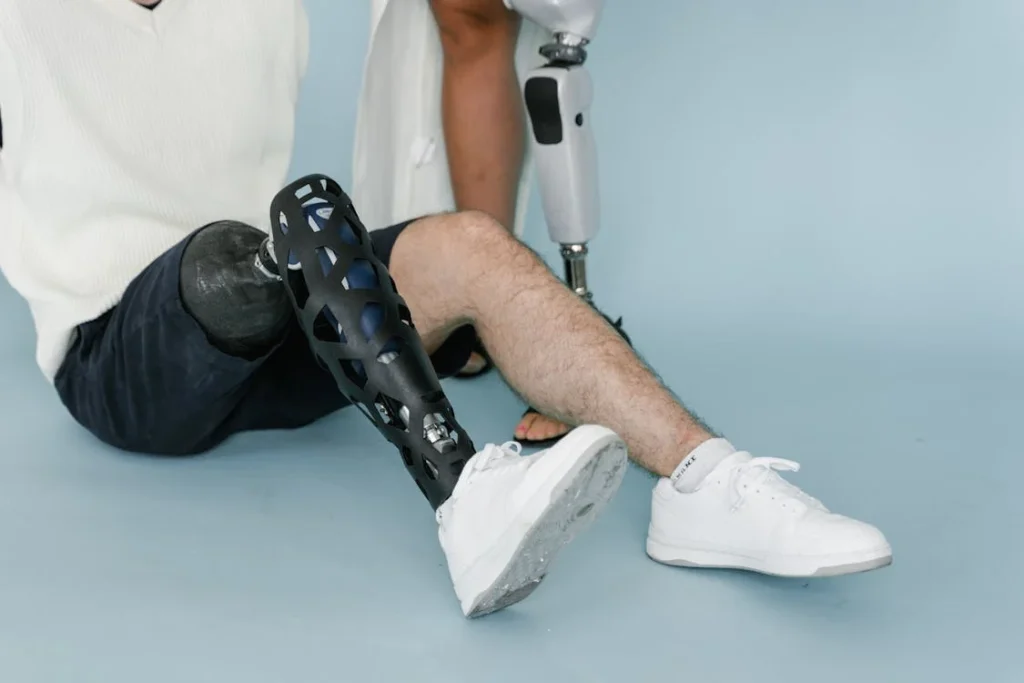Recovering from a lower-limb amputation is a journey that involves both physical and emotional adjustments. While the surgery itself is a major step, the real challenge begins afterward—learning to move again, managing pain, and adapting to a new way of life. Many people find this process overwhelming, but with the right approach and support, recovery can be smooth and empowering.
Every amputee faces unique challenges based on their health, level of amputation, and lifestyle. Some struggle with phantom limb pain, while others find it difficult to regain balance and mobility. Emotional hurdles, such as frustration or loss of confidence, can also slow progress. However, with proper rehabilitation, prosthetic solutions, and a strong support system, these challenges can be overcome.
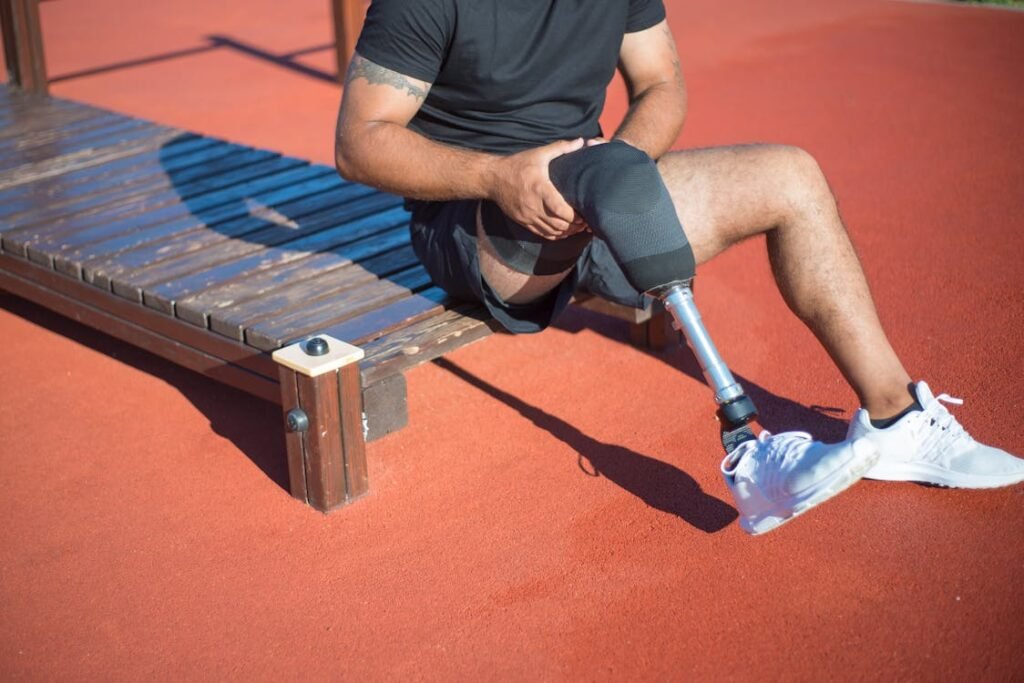
Managing Pain and Discomfort After Amputation
Pain management is one of the biggest challenges in lower-limb amputation recovery. The body needs time to heal from surgery, and during this period, pain can come in different forms.
Some experience soreness at the surgical site, while others feel discomfort as they begin moving again. Understanding these types of pain and how to manage them is essential for a smoother recovery.
Post-Surgical Pain and Healing
After an amputation, the residual limb goes through a healing process that can take weeks or months. During this time, swelling, tenderness, and sensitivity are common.
Doctors usually prescribe pain medication to help with the initial discomfort, but other methods such as elevation, compression bandages, and gentle stretching can also help reduce pain.
Keeping the wound clean and following medical advice prevents infections, which can slow down recovery and cause additional pain.
Swelling in the residual limb can make it difficult to wear a prosthetic comfortably. Using a compression sock or wrapping the limb helps control swelling and prepares it for a prosthetic fitting.
Physical therapy also plays an important role in keeping the limb flexible and preventing stiffness, which can lead to further discomfort.
Phantom Limb Pain and Sensations
One of the most unusual experiences after amputation is phantom limb pain. Many people feel as if their missing leg or foot is still there, sometimes experiencing tingling, itching, or even sharp pain in the area where the limb used to be.
This happens because the brain is still receiving signals from the nerves that once controlled the missing limb.
Phantom pain can be frustrating, but there are ways to manage it. Mirror therapy, where a mirror is used to trick the brain into seeing the missing limb, has been helpful for many amputees.
Massage, heat therapy, and certain medications can also provide relief. In some cases, adjusting the prosthetic or changing movement patterns helps reduce the intensity of phantom sensations.
Pain Related to Prosthetic Use
For those using a prosthetic limb, discomfort may arise as they adjust to wearing it. If the socket does not fit properly, it can cause irritation or pressure sores. Regular visits to a prosthetist ensure that the fit is comfortable and that adjustments are made when necessary.
Building strength in the muscles surrounding the residual limb helps improve comfort. If a person relies too much on one side of the body, they may develop muscle imbalances, leading to back or hip pain.
Physical therapy helps distribute weight evenly, improving posture and reducing strain on the rest of the body.
Adapting to a prosthetic takes time, and minor discomfort is normal in the beginning. However, if pain becomes severe or persistent, it is important to seek professional help.
A well-fitted prosthetic, combined with proper training and rehabilitation, allows for greater comfort and mobility over time.
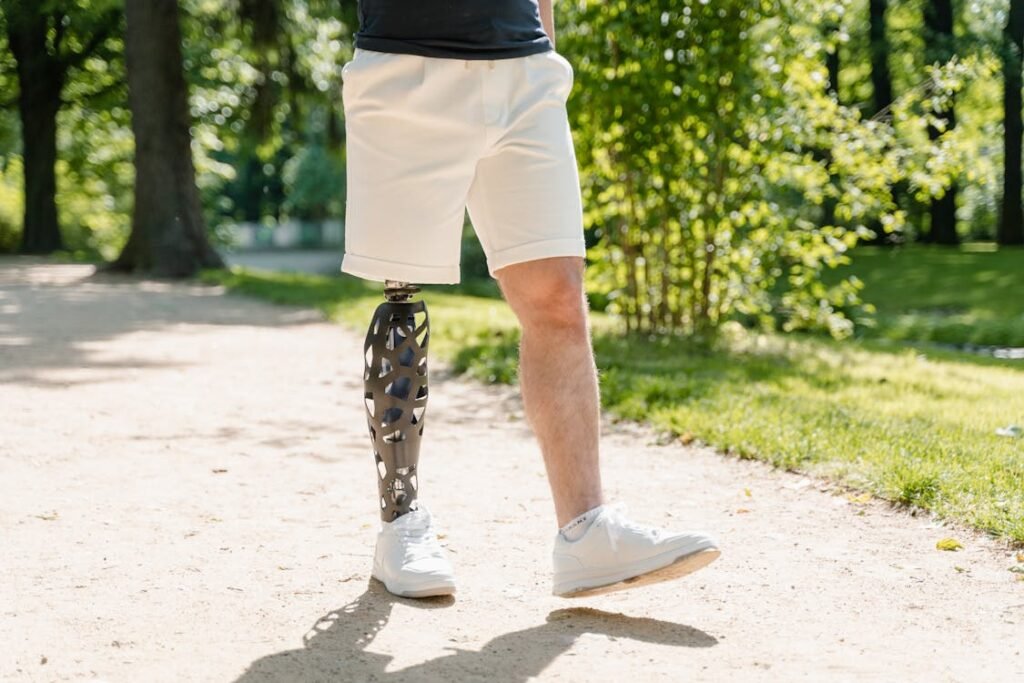
Regaining Balance and Mobility
After a lower-limb amputation, one of the biggest challenges is learning how to move with stability and confidence again.
The body must adjust to a new center of gravity, and even simple actions like standing up or shifting weight from one side to another can feel different.
Regaining balance and mobility is a gradual process, but with the right approach, it becomes easier over time.
Building Core Strength for Stability
Balance starts with a strong core. The muscles in the abdomen and lower back help keep the body upright and steady.
After an amputation, these muscles work harder to compensate for the missing limb. If the core is weak, movements can feel unstable, and the risk of falling increases.
Physical therapists focus on exercises that strengthen the core, improve posture, and help distribute weight evenly. Simple activities like seated exercises, controlled movements, and resistance training can make a significant difference.
Over time, these exercises build the strength needed to walk confidently, whether using a prosthetic or another mobility aid.
Training the Body to Walk Again
Walking after an amputation requires retraining the body. If a prosthetic limb is being used, it takes time to adjust to its weight and mechanics.
The key is to develop a smooth, natural gait that does not put excess strain on other parts of the body. Without proper training, some people develop habits such as leaning too much on the intact limb or taking uneven steps, which can lead to pain in the hips and lower back.
Gait training helps correct these patterns. Physical therapists guide amputees through step-by-step exercises that teach how to place the foot properly, shift weight correctly, and maintain rhythm while walking.
Many people start by walking on parallel bars, using their arms for support before progressing to walking independently. As confidence grows, training includes navigating slopes, stairs, and uneven terrain to prepare for real-world situations.
Overcoming Fear of Falling
Many amputees experience fear of falling, especially in the early stages of recovery. This fear can lead to hesitation and stiffness, making movement even more difficult.
The best way to overcome this is through practice and controlled exposure. The more a person moves, the more their brain and muscles adapt to the new way of walking.
Using mobility aids, such as crutches or walkers, can provide extra support until balance improves. Over time, as strength and confidence grow, the need for these aids may reduce.
For those using a prosthetic, working closely with a prosthetist ensures that the fit is correct, which plays a big role in preventing falls.
Adapting to Different Environments
Walking on smooth indoor floors is one thing, but navigating outdoor paths, sidewalks, or uneven surfaces requires additional skills. Learning how to adjust movements for different environments is an important part of mobility training.
Techniques such as using small, controlled steps on gravel, adjusting stride on inclines, and stepping cautiously on wet surfaces help amputees move safely in various conditions.
Practicing these movements in therapy sessions allows individuals to gain confidence before encountering them in daily life.
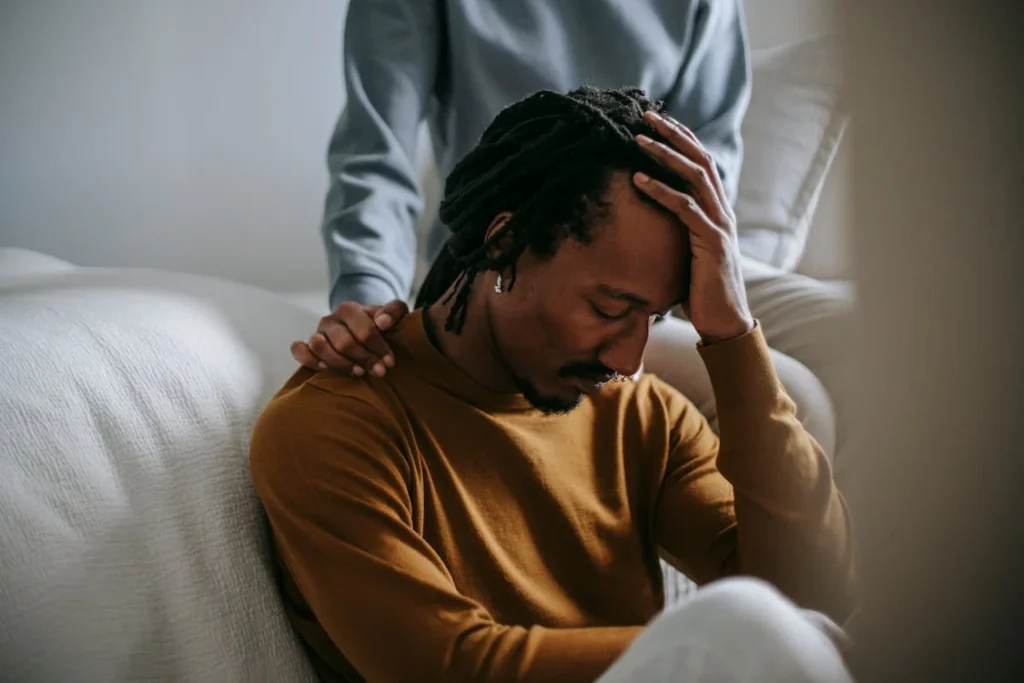
Emotional and Psychological Challenges in Recovery
Recovering from a lower-limb amputation is not just a physical process—it is also an emotional and psychological journey. Many amputees experience a wide range of emotions, from frustration and grief to determination and hope.
The mental aspect of recovery is just as important as the physical, and addressing emotional challenges early can make the transition smoother.
Coping with Grief and Loss
An amputation is a life-changing event, and it is natural to go through a period of grief. Losing a limb can feel like losing a part of one’s identity, leading to feelings of sadness, frustration, or even anger.
Some people struggle with accepting their new body image, while others feel anxious about how they will adjust to daily life. These emotions are completely normal, and it is important to allow time for processing them.
Talking to a counselor or therapist can be helpful in navigating these emotions. Support groups also provide a space to connect with others who have gone through similar experiences.
Knowing that others have faced the same struggles and found ways to move forward can be incredibly reassuring.
Rebuilding Confidence and Independence
One of the biggest concerns for many amputees is whether they will be able to regain their independence. Simple activities that were once effortless—like getting out of bed, dressing, or walking—may now require more effort and adaptation.
The key to rebuilding confidence is to focus on small victories.
Each milestone, whether it is standing without assistance, walking a few steps, or using a prosthetic comfortably, is a step forward.
Celebrating progress, no matter how small, reinforces a positive mindset. Rehabilitation specialists and occupational therapists provide strategies for adapting daily activities, ensuring that individuals can perform tasks safely and independently.
Dealing with Social Anxiety and Public Perception
Returning to social life after an amputation can feel overwhelming. Many amputees worry about how others will react to their prosthetic limb or mobility aid. Some fear being stared at in public or having to explain their amputation to others.
These concerns can lead to social withdrawal or avoidance, which can negatively impact mental health.
The first step in overcoming social anxiety is realizing that most people are simply curious and not judgmental. Deciding in advance how much information to share can make interactions easier.
Some individuals feel comfortable openly discussing their experience, while others prefer to keep details private. Both approaches are valid, and it is up to the individual to set their boundaries.
Practicing social interactions in safe environments, such as family gatherings or small outings, can help build confidence before venturing into larger public spaces. Over time, the focus shifts away from what others think and towards enjoying life without self-consciousness.
Staying Motivated During Recovery
Recovery is not a straight path—there are good days and difficult days. Some moments may feel discouraging, especially when progress seems slow.
Having a strong support system makes a big difference. Family, friends, therapists, and fellow amputees can provide encouragement and reminders of how far one has come.
Setting realistic goals keeps motivation high. Whether it is walking a certain distance, learning to climb stairs, or returning to work, having clear milestones provides a sense of purpose.
Recognizing achievements along the way reinforces the belief that life after amputation can be just as fulfilling as before.

Adapting to Daily Life After Amputation
Recovery from a lower-limb amputation extends beyond medical rehabilitation—it involves adapting to daily routines, home environments, and lifestyle changes.
The ability to perform everyday activities independently is a key factor in regaining confidence and a sense of normalcy. With the right strategies and tools, amputees can successfully transition back to an active and fulfilling life.
Modifying the Home for Safety and Comfort
The home environment plays a crucial role in post-amputation recovery. After surgery, moving around may feel different, and certain areas of the house may require adjustments for safety and ease of movement.
Minimizing obstacles, creating accessible pathways, and ensuring stable furniture can reduce the risk of falls and make navigation smoother.
For individuals using a prosthetic, having handrails in bathrooms, ramps in place of stairs, and non-slip flooring can make a significant difference.
If standing for long periods is difficult, placing stools in key areas, such as the kitchen or shower, allows for breaks when needed. As mobility improves, these modifications may no longer be necessary, but they offer essential support during the initial recovery phase.
Mastering Self-Care and Household Tasks
Daily self-care routines, such as dressing, bathing, and cooking, may require some adjustment after an amputation. Occupational therapists provide training on how to adapt these activities efficiently.
Simple techniques, such as sitting while dressing or using reachers for items on high shelves, can make everyday tasks easier.
Cooking and cleaning can also be modified to reduce strain. Using adaptive kitchen tools, preparing meals while seated, and rearranging frequently used items to more accessible locations help maintain independence.
Over time, as balance and mobility improve, these tasks become more manageable without extra effort.
Returning to Work and Community Activities
Reintegrating into the workplace and social settings is an important part of long-term recovery. Many amputees wonder if they can return to their previous job or if workplace modifications will be necessary.
The good news is that most employers are willing to provide accommodations, whether through adjusted workstations, flexible hours, or modified responsibilities.
Speaking with a supervisor about any concerns before returning to work helps set realistic expectations. Some individuals choose to gradually transition back to work with part-time hours before resuming full-time duties.
Depending on the job role, assistive devices or ergonomic tools can improve efficiency and comfort.
Social interactions may also require adjustment. Some people feel hesitant about attending events or participating in activities they once enjoyed.
The key is to take small steps toward re-engaging with the community, whether by visiting familiar places, attending small gatherings, or trying new activities that accommodate mobility changes.
Staying Active and Maintaining Physical Health
Movement and exercise are crucial for maintaining long-term health after an amputation. Staying active helps prevent muscle loss, improve circulation, and strengthen the remaining limb, all of which contribute to overall mobility.
For individuals using a prosthetic, regular walking exercises help build endurance and improve gait patterns. Low-impact activities such as swimming, cycling, or adaptive yoga provide excellent cardiovascular benefits without excessive strain.
Many amputees also explore adaptive sports, finding new ways to stay active and engaged in recreational activities.
Maintaining a healthy diet and proper hydration also plays a role in recovery. Nutrition impacts energy levels, wound healing, and overall strength.
Eating balanced meals with enough protein, vitamins, and minerals supports muscle function and improves stamina, making daily activities easier to manage.
Adapting to Life with Confidence
Adapting to daily life after an amputation is a process that takes time, but each challenge overcome builds confidence. With proper adjustments, training, and a supportive environment, individuals can regain independence, mobility, and a sense of normalcy.
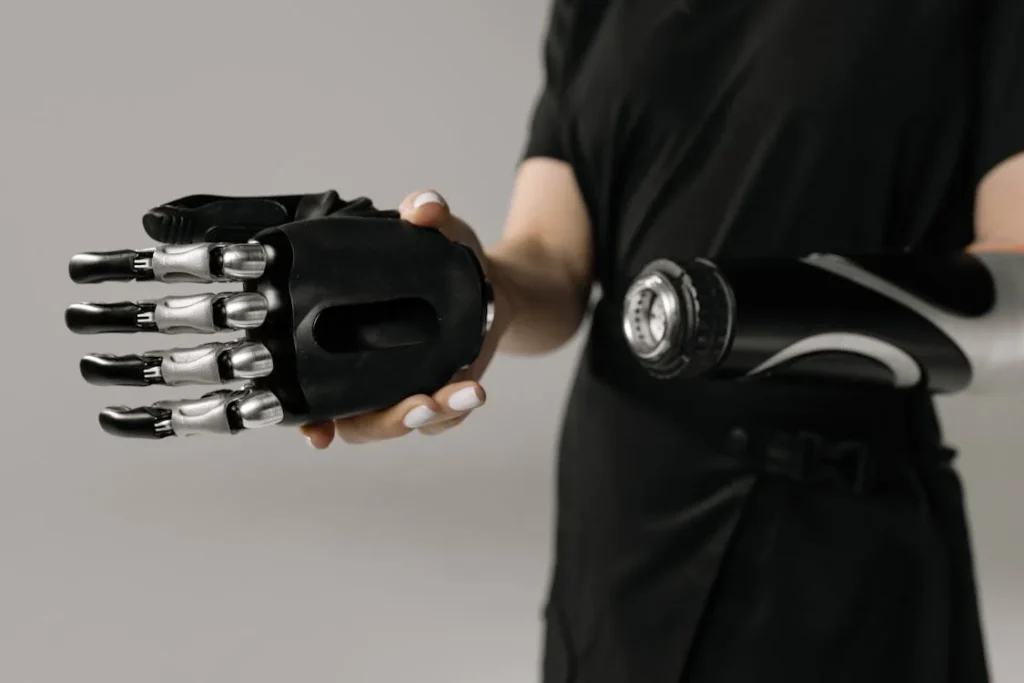
The Role of Prosthetic Technology in Recovery
For many lower-limb amputees, a prosthetic limb plays a crucial role in regaining mobility and independence. Modern prosthetics have come a long way, offering greater comfort, better functionality, and improved adaptability to different lifestyles.
However, adjusting to a prosthetic takes time, and understanding how to use it effectively is an important part of the recovery process.
Choosing the Right Prosthetic Limb
Selecting the right prosthetic depends on several factors, including the level of amputation, lifestyle needs, and personal goals.
Some individuals require a basic prosthetic for everyday walking, while others may need a more advanced model designed for sports or physically demanding activities.
Working with a prosthetist helps determine the best fit, ensuring that the limb is comfortable, durable, and suited to the wearer’s needs.
A well-fitted prosthetic provides balance, support, and stability, reducing strain on the rest of the body. If a prosthetic is too loose, too tight, or poorly aligned, it can cause discomfort and even lead to long-term issues such as hip or back pain.
Regular adjustments are necessary, especially in the early months, as the residual limb changes shape and adapts to weight-bearing.
Learning to Walk with a Prosthetic
Walking with a prosthetic limb is different from natural movement, and it takes practice, patience, and professional guidance to master.
Gait training helps amputees develop smooth and efficient walking patterns, preventing unnatural compensations that can lead to pain or fatigue.
Physical therapists guide individuals through exercises that strengthen the hip, core, and remaining limb, which all play a role in stabilizing movement. The goal is to achieve a natural, controlled stride, allowing for comfortable and confident walking in different environments.
In the beginning, many amputees feel unsure about putting full weight on the prosthetic. This hesitation is normal, but gradual weight-bearing exercises help build confidence.
Practicing on flat surfaces first, then progressing to slopes, stairs, and uneven ground, ensures that the body adapts to real-world conditions.
Overcoming Challenges in Prosthetic Use
It is common to face discomfort, balance issues, or minor skin irritation when first using a prosthetic. These challenges can be managed with regular checkups, adjustments, and proper care.
Maintaining good skin hygiene, wearing the right prosthetic liner, and using soft padding help prevent pressure sores.
Some amputees experience phantom limb discomfort while using their prosthetic, as the brain is still adjusting to the missing limb.
In such cases, techniques like desensitization exercises, massage therapy, or mirror therapy can help reduce sensations and make prosthetic use more comfortable.
For those who engage in sports or physically demanding activities, specialized prosthetics provide greater flexibility, shock absorption, and enhanced movement.
Running blades, waterproof prosthetics, and high-performance models offer amputees the freedom to engage in a wide range of activities.
Maintaining and Upgrading Prosthetics
A prosthetic limb is not a one-time investment—it requires regular maintenance to ensure optimal function. Over time, wear and tear can affect the fit, especially as the residual limb changes.
Scheduling routine prosthetic checkups with a specialist ensures that the socket, alignment, and overall mechanics remain in good condition.
As technology advances, many amputees upgrade to more advanced prosthetics with features like microprocessor-controlled knees, better energy return, and improved grip strength for upper-limb prosthetics.
These innovations make movement easier and more natural, further enhancing the quality of life.
With the right prosthetic technology, training, and support, amputees can move with confidence, pursue their goals, and reclaim their independence.
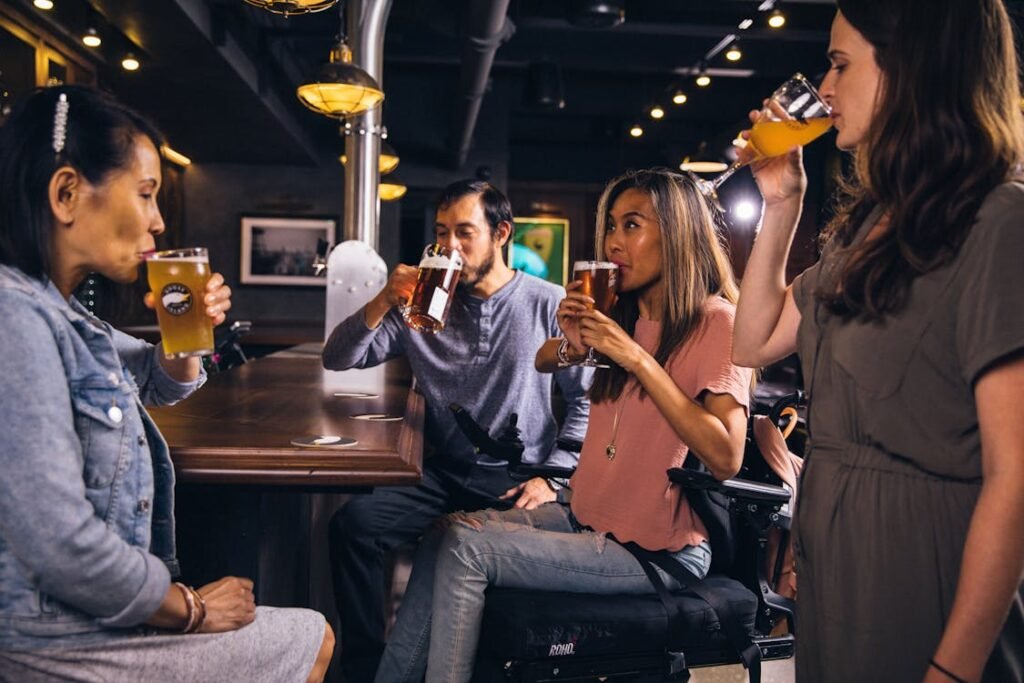
The Importance of a Strong Support System in Recovery
Recovering from a lower-limb amputation is not a journey that should be faced alone. Having a strong support system—whether from family, friends, healthcare providers, or peer groups—makes a significant difference in both physical and emotional healing.
Encouragement from loved ones and professionals helps amputees navigate the challenges of recovery, regain confidence, and stay motivated.
Family and Friends: The Foundation of Emotional Support
Family and close friends play a vital role in an amputee’s recovery. Their presence provides emotional stability, reassurance, and a sense of normalcy.
Many amputees go through moments of frustration, sadness, or doubt, and having loved ones who listen, encourage, and assist with daily tasks makes the transition smoother.
Simple acts, such as helping with mobility, accompanying the amputee to medical appointments, or just being present during challenging moments, create a positive impact.
However, it is also important for family members to encourage independence rather than doing everything for the amputee. A balance between support and allowing the individual to regain self-sufficiency helps build confidence.
Healthcare Professionals: Guiding the Recovery Process
Rehabilitation specialists, physical therapists, prosthetists, and doctors all play essential roles in an amputee’s recovery.
These professionals provide structured guidance, practical training, and ongoing medical care, ensuring that each step of the process is managed safely and effectively.
Physical therapists work on gait training, strength-building, and mobility improvement, helping amputees adjust to movement with or without a prosthetic.
Prosthetists ensure that the fit and function of the prosthetic limb remain optimal, making adjustments as needed. Regular check-ins with healthcare providers allow for tracking progress, addressing discomfort, and making modifications to recovery plans when necessary.
Peer Support: Learning from Others Who Have Walked the Same Path
Connecting with other amputees who have gone through similar experiences can be incredibly uplifting. Peer support groups provide a space for sharing challenges, successes, and practical advice.
Many amputees find motivation by seeing others who have successfully adapted to their new way of life, whether through returning to work, engaging in sports, or simply moving forward with confidence.
Peer mentors—individuals who have already adjusted to life after amputation—offer first-hand insights that medical professionals may not always cover.
They provide encouragement, answer questions about daily life, and help new amputees set realistic expectations for their recovery journey.
Overcoming Isolation and Staying Connected
Some amputees withdraw from social activities due to self-consciousness or anxiety about how others will react. This can lead to feelings of isolation, which negatively impact mental well-being.
Staying engaged with friends, participating in hobbies, and gradually reintegrating into social settings help rebuild confidence.
Online communities and amputee-focused organizations also offer valuable support. Virtual forums and local meetups create opportunities to ask questions, share experiences, and find encouragement from people who truly understand the journey.
With the right support system in place, the road to recovery becomes less overwhelming.
Emotional encouragement, expert guidance, and connections with others help amputees regain independence, rebuild confidence, and look forward to a fulfilling life beyond amputation.
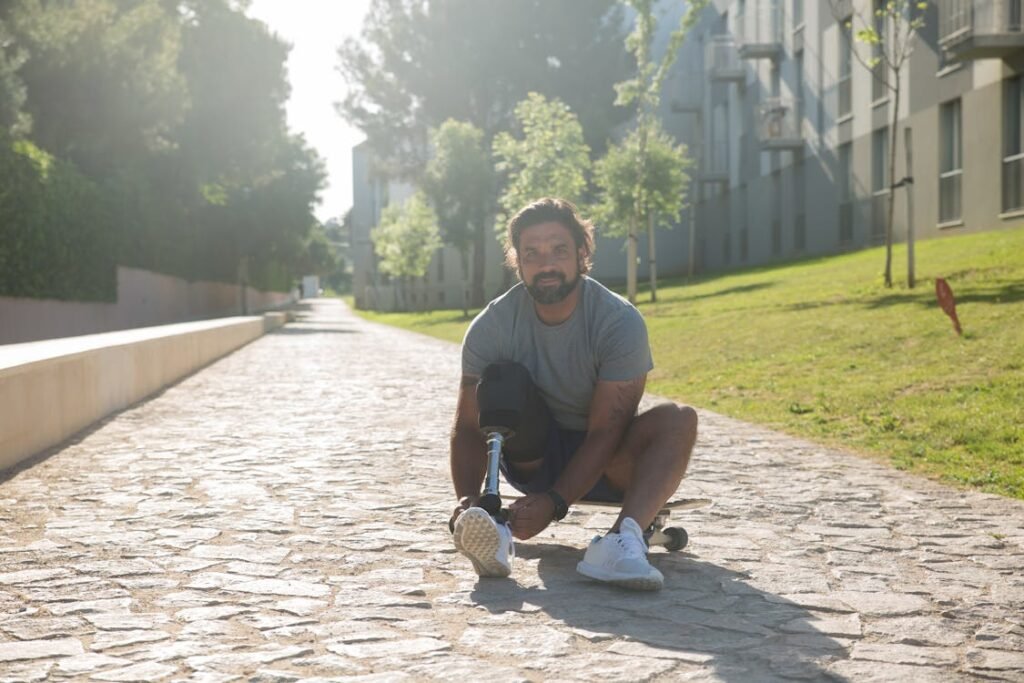
Long-Term Rehabilitation and Maintaining Progress
Recovering from a lower-limb amputation does not end once an individual learns to walk again or adjusts to their prosthetic. Long-term rehabilitation is essential for maintaining mobility, preventing complications, and improving overall quality of life.
Staying active, making lifestyle adjustments, and continuing follow-up care ensure that amputees can lead fulfilling and independent lives.
Staying Active and Preventing Muscle Loss
Regular movement is crucial for keeping muscles strong and preventing stiffness. After an amputation, the body must compensate for the missing limb, and without consistent exercise, muscle imbalances, joint pain, and posture issues can develop over time.
Engaging in daily physical activities, such as walking, stretching, or using resistance bands, keeps the body flexible and strong. For those with a prosthetic, practicing proper walking techniques reduces strain on the intact limb and improves overall balance.
Adaptive fitness programs, such as swimming, yoga, or cycling, offer additional ways to stay active while minimizing impact on the joints.
Physical therapists often recommend strength training exercises to build endurance and maintain proper posture. Targeting the core, back, and residual limb muscles prevents fatigue and improves overall movement efficiency.
Staying consistent with these exercises ensures that mobility continues to improve long after initial rehabilitation.
Avoiding Long-Term Strain and Overuse Injuries
Many amputees unknowingly develop habits that put excessive strain on certain parts of the body. Common issues include leaning too much on the intact leg, overusing the lower back, or compensating for a poorly fitted prosthetic.
These patterns can lead to chronic pain, arthritis, or joint wear over time.
Regular check-ins with a physical therapist help correct improper movement habits before they cause long-term damage.
If discomfort arises, early intervention—such as adjusting prosthetic alignment, modifying walking techniques, or incorporating new stretches—prevents complications from worsening.
For those who rely on crutches or mobility aids, switching weight distribution between arms and legs prevents muscle fatigue and joint stress.
Alternating between assistive devices and prosthetic use when needed ensures that the body does not become overworked in one specific area.
Routine Prosthetic Maintenance and Adjustments
A prosthetic limb is not a static device—it requires ongoing adjustments to remain functional and comfortable. Over time, the residual limb may change in shape or size, affecting the fit of the prosthetic socket.
If left unaddressed, an ill-fitting prosthetic can cause pressure sores, skin irritation, and discomfort.
Scheduling regular appointments with a prosthetist ensures that the limb remains in optimal condition. Adjustments to the socket, alignment, or padding improve fit and prevent unnecessary strain on the rest of the body.
If a prosthetic begins to feel uncomfortable or movement becomes restricted, seeking professional guidance as soon as possible prevents further complications.
Some individuals choose to upgrade their prosthetic limb as technology advances. More advanced models with improved energy return, better shock absorption, and microprocessor-controlled knees or feet allow for more natural movement and less effort when walking.
Exploring these options with a prosthetist can provide long-term benefits for mobility and comfort.
Monitoring Overall Health and Well-Being
A lower-limb amputation affects more than just mobility—it also impacts overall health. Amputees should monitor their weight, cardiovascular health, and skin condition to prevent complications that may arise from reduced activity levels or improper prosthetic use.
Maintaining a balanced diet rich in protein, vitamins, and healthy fats supports muscle strength and tissue repair. Proper hydration prevents cramps and improves circulation, which is especially important for individuals with conditions such as diabetes or vascular disease.
Good skin care is essential for preventing irritation, infections, or sores on the residual limb. Cleaning the limb daily, checking for redness or pressure points, and using appropriate liners or padding reduce the risk of complications.
Regular medical check-ups allow healthcare providers to assess mobility, prosthetic function, and overall physical health. If new challenges arise, early intervention ensures that they are addressed before they impact daily life.
Living a Fulfilling Life Beyond Recovery
Long-term rehabilitation is not just about maintaining physical function—it is about ensuring that amputees continue to live an active, independent, and fulfilling life.
By staying proactive in health management, seeking ongoing support, and making necessary adjustments, individuals can enjoy mobility, engage in meaningful activities, and embrace new opportunities.
Conclusion
Recovering from a lower-limb amputation is a journey filled with challenges, but it is also an opportunity for growth, resilience, and renewed independence. While the process may seem overwhelming at first, each step—whether managing pain, learning to walk again, or adjusting to daily life—brings progress. With the right mindset, proper rehabilitation, and a strong support system, amputees can regain mobility and confidence.
Overcoming common recovery challenges requires patience, persistence, and the right tools. From physical therapy and prosthetic training to emotional support and lifestyle adjustments, every aspect of recovery plays a role in shaping a successful transition. The key is to stay committed, seek help when needed, and celebrate even the smallest victories.
At Robobionics, we believe that every amputee deserves the chance to live life without limitations. Our advanced prosthetic solutions, expert rehabilitation support, and commitment to accessibility empower individuals to move forward with strength and confidence.



